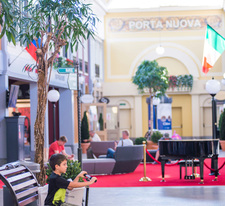Outlet: inside out and face
Managing Director of FASHION HOUSE Group Brandon O'Reilly "about why it is now more profitable for former customers of Warsaw and Milan outlets to buy in Moscow and St. Petersburg, how outlets without a roof still don't work in Russia, and how many more sale projects the Russian market will withstand.

– You have always criticized the concept of «open» outlets for the Nordic countries, noting that in Russia, for example, it is almost a non-viable story.
However, most developers in Russia prefer projects without a roof, which, of course, significantly reduces investment, but is not justified from the point of view of the convenience of visitors. At FASHION HOUSE Group, we believe that the architectural solution and design of the outlet should take into account the peculiarities of shopping. On average, a customer spends 140–180 minutes in an outlet during one visit, whereas in a regular shopping center – only 20–40 minutes. So comfort is more important here. And it is no less relevant for tenants: satisfied buyers return, which is reflected in business indicators. That is why FASHION HOUSE Group, unlike other developers, builds fully covered centers. Considering the climatic conditions in Russia, the roof and air conditioning are simply necessary conditions in order to ensure regular attendance, regardless of the weather.

Has your attitude towards outlets near airports, in new TPU, at train stations changed?
– Probably, you yourself don't often think about shopping when you go to the airport. The only thing you think about is how not to miss your flight. Once an airport outlet was built in Sweden, and everyone expected that hundreds of thousands of people would pass in the immediate vicinity. Yes, they pass – but by. People don't want to shop either on the way to or from the airport, because then they also want to get to their home or hotel as quickly as possible. There was a failure with airport projects in Prague, Rome, and Stockholm. Of course, there is cheap land near airports, and besides, they were built without a roof, but the attendance in the end was very low. And it's not just the location. First of all, we have to offer the buyer some kind of unique experience – invite him to where he wants to stay, meet friends, collect some images. External architecture and interior design help in this. That's why each outlet scheme developed by us has its own unique architectural theme and design. In Moscow, this is a traditional style in the spirit of the old buildings of the capital. In St. Petersburg - Holland, with which the city traditionally had trade relations. The interiors both there and there are made in the style of "Window to Europe";: Visitors are greeted by the streets of London, Milan and Paris.

– Now all shopping centers in Russia talk about themselves as "palaces of entertainment, shopping and food". However, we all remember how in the USA the projects of "lifestyle centers", which put on the synergy of outlets, entertainment and family holidays, failed miserably.
If we talk about the outlet industry, today it is just facing the need to develop the leisure and restaurant component. Food is becoming a new fashion.Visitors are increasingly looking for an entertaining shopping experience. They don't just come to find the right brand, but they want to have a good time at the outlet center and have lunch. This means that those who run outlets should think about expanding the food court and offer customers a wide selection of restaurants and cafes with different cuisines, different service, in different styles. And in general, think about how you can diversify your leisure time in order to continue to run a successful business.
It is expected that against the background of new sanctions packages, foreign companies, including the fashion segment, will continue to leave the Russian market. How would you recommend brands to behave in these conditions?
Today, the outlet market is centered around Moscow. The leading position of the capital is not surprising - there is a high population density and financial potential. The situation will not change in the near future, since the Moscow market is not yet saturated enough. However, interests in the real estate investment market are shifting towards the regions. Companies are looking more and more intently beyond the borders of Moscow. And here, without a doubt, St. Petersburg is seen in the first place. This is a very promising arena for outlets.
Interviewed by Evgeny Arsenin
Photo: FASHION HOUSE Group











